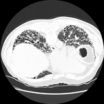"With the rise in demand and growing waiting lists for sleep physician consultation and laboratory-based sleep services, there has been increasing interest in development of ambulatory strategies for the diagnosis and management of OSA involving home sleep monitoring and auto-titrating continuous positive airway pressure (CPAP)," said lead author Ching Li Chai-Coetzer, MBBS, of the Adelaide Institute for Sleep Health at Repatriation General Hospital in Australia. "While previous studies have demonstrated that ambulatory models of care for OSA in specialist settings can produce patient outcomes which are comparable to laboratory-based management, this is the first randomised controlled study to be conducted in primary care."
The results will be presented at the ATS 2012 International Conference in San Francisco.
"We randomized 155 patients to either primary care-based management or usual care in a specialist sleep center," said Dr. Chai-Coetzer. "At six months, mean change in Epworth sleepiness scale (ESS) scores, the primary outcome measure of the study, was similar in the two groups (4.9 in the primary care group vs. 5.1 in the specialist group)."
PCPs identified patients with symptomatic, moderate-to-severe OSA using a four-item screening tool, the ESS, and home oximetry. Primary care-based management was led by the patient's PCP and a community-based nurse and involved use of home auto-titrating continuous positive airway pressure (CPAP). Usual care in a specialist sleep center involved management by a sleep physician and laboratory-based testing.
In addition to similar changes in ESS scores at six months, mean change in Functional Outcomes of Sleep Questionnaire (FOSQ) score was similar in the two groups (2.3 in the primary care group vs. 2.7 in the specialist group), as was compliance with CPAP. Mean daily use of CPAP was 4.8 (±2.1) hours in the primary care group and 5.4 (±1.8) hours in the specialist group.
Furthermore, within-study costs for primary care management were lower than those for specialist care, with significant savings of AUD$2157 (95% CI: $1293 to $3114) per patient.
"Our results show that using a simplified, ambulatory approach for the treatment of OSA in primary care is not clinically inferior to management of these patients in a specialist sleep center," concluded Dr. Chai-Coetzer. "This approach also offers a lower cost alternative to usual care. In addition, waiting lists for specialist sleep centers are long, and home care may be preferred by patients.
"With adequate training of PCPs and their practice nurses and appropriate funding models to support an ambulatory strategy, primary care management of OSA has the potential to reduce the burden of disease in the community by improving patient access to sleep services. This would be particularly beneficial for rural and remote regions, as well as developing nations, where access to specialist services may be limited."
###
"A Randomised Controlled Trial To Evaluate A Simplified Model Of Care For Obstructive Sleep Apnea In Primary Care" (Session B108, Monday, May 21, 2012: 2:00-4:30 p.m., Room 3009, Moscone Center; Abstract 28432)
* Please note that numbers in this release may differ slightly from those in the abstract. Many of these investigations are ongoing; the release represents the most up-to-date data available at press time.
ABSTRACT:
A Randomised Controlled Trial To Evaluate A Simplified Model Of Care For Obstructive Sleep Apnea In Primary Care
Type: Scientific Abstract
Category: 16.03 - Sleep Disordered Breathing: Diagnosis and Management (SRN)
Authors: C.L. Chai-Coetzer1, N.A. Antic1, L.S. Rowland1, R.L. Reed2, A. Esterman3, P. Catcheside1, N. Vowles1, H. Williams4, S. Dunn5, R.D. McEvoy1; 1Repatriation
General Hospital - Adelaide, SA/AU, 2Flinders University - Adelaide, SA/AU, 3University of South Australia - Adelaide, SA/AU, 4General Practice Network South - Adelaide/AU, 5Charles Darwin University - Dariwn, SA/AU
Abstract Body
RATIONALE: There has been growing interest in ambulatory models of care for obstructive sleep apnea (OSA) involving screening questionnaires, portable home monitors and/or auto-titrating continuous positive airway pressure (CPAP). With appropriate training and provision of simplified management tools, primary care physicians (PCPs) are ideally positioned to take on a greater role in the diagnosis and treatment of OSA. The aim of this randomised controlled study was to compare a simplified model of care for OSA in the primary care setting versus the usual standard of care in a specialist sleep centre.
METHODS: Patients with symptomatic, moderate-to-severe OSA were identified by PCPs using a 4-item screening tool, the Epworth sleepiness scale (ESS) and home oximetry (ApneaLink, ResMed). Eligible patients were randomised into either one of two models of care: (1) Primary care-based management, led by their PCP and a community-based nurse, involving home auto-titrating CPAP, or (2) Usual care in a specialist sleep centre, involving sleep physician management and laboratory-based testing. Outcome measures included the change in ESS, change in functional outcomes of sleep questionnaire (FOSQ) and CPAP compliance after 6 months of follow-up.
RESULTS: 155 patients were randomised into the study. For the primary outcome measure, the mean change in ESS score at 6 months, primary care-based management was not inferior to Specialist-led management (4.9 vs 5.1; adjusted mean difference -0.5 [lower bound of one-sided 95% confidence interval {CI}: -1.6], p=0.47) using an a priori noninferiority margin of -2.0. Similar results were also seen for the mean change in FOSQ score at 6 months (2.3 vs 2.7; adjusted mean difference -0.06 [lower bound of one-sided 95% CI: -0.6], p=0.87) when using an a priori noninferiority margin of -1.0. CPAP compliance at 6 months was comparable in the two treatment arms, with mean (± SD) daily use of 4.8 (± 2.1) hours in the primary care-based group versus 5.4 (± 1.8) hours in the Specialist group (p=0.1).
CONCLUSION: Outcomes for patients with symptomatic, moderate-to-severe OSA managed in primary care using a simplified, ambulatory approach which utilises the skills of appropriately trained PCPs and community-based nurses are not clinically inferior to usual management in a specialist sleep centre.
Funded by: National Health and Medical Research Council of Australia
END
